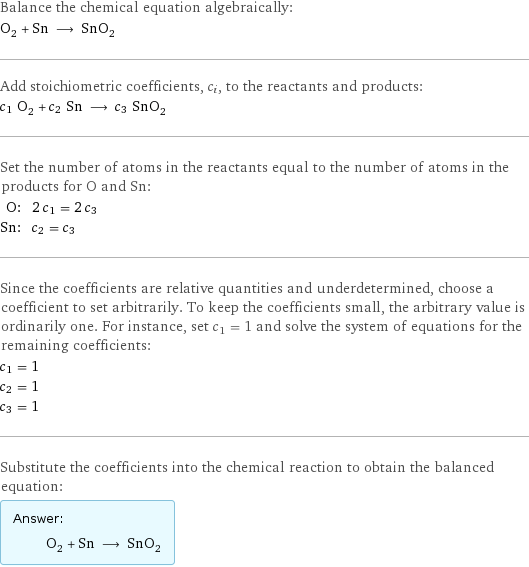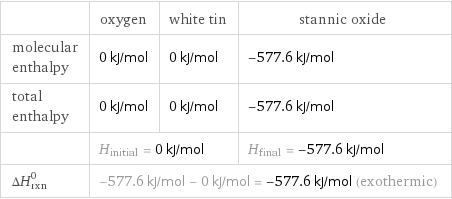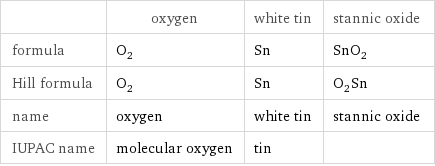Input interpretation

O_2 oxygen + Sn white tin ⟶ SnO_2 stannic oxide
Balanced equation

Balance the chemical equation algebraically: O_2 + Sn ⟶ SnO_2 Add stoichiometric coefficients, c_i, to the reactants and products: c_1 O_2 + c_2 Sn ⟶ c_3 SnO_2 Set the number of atoms in the reactants equal to the number of atoms in the products for O and Sn: O: | 2 c_1 = 2 c_3 Sn: | c_2 = c_3 Since the coefficients are relative quantities and underdetermined, choose a coefficient to set arbitrarily. To keep the coefficients small, the arbitrary value is ordinarily one. For instance, set c_1 = 1 and solve the system of equations for the remaining coefficients: c_1 = 1 c_2 = 1 c_3 = 1 Substitute the coefficients into the chemical reaction to obtain the balanced equation: Answer: | | O_2 + Sn ⟶ SnO_2
Structures

+ ⟶
Names

oxygen + white tin ⟶ stannic oxide
Reaction thermodynamics
Enthalpy

| oxygen | white tin | stannic oxide molecular enthalpy | 0 kJ/mol | 0 kJ/mol | -577.6 kJ/mol total enthalpy | 0 kJ/mol | 0 kJ/mol | -577.6 kJ/mol | H_initial = 0 kJ/mol | | H_final = -577.6 kJ/mol ΔH_rxn^0 | -577.6 kJ/mol - 0 kJ/mol = -577.6 kJ/mol (exothermic) | |
Entropy

| oxygen | white tin | stannic oxide molecular entropy | 205 J/(mol K) | 51.2 J/(mol K) | 52 J/(mol K) total entropy | 205 J/(mol K) | 51.2 J/(mol K) | 52 J/(mol K) | S_initial = 256.2 J/(mol K) | | S_final = 52 J/(mol K) ΔS_rxn^0 | 52 J/(mol K) - 256.2 J/(mol K) = -204.2 J/(mol K) (exoentropic) | |
Equilibrium constant
![Construct the equilibrium constant, K, expression for: O_2 + Sn ⟶ SnO_2 Plan: • Balance the chemical equation. • Determine the stoichiometric numbers. • Assemble the activity expression for each chemical species. • Use the activity expressions to build the equilibrium constant expression. Write the balanced chemical equation: O_2 + Sn ⟶ SnO_2 Assign stoichiometric numbers, ν_i, using the stoichiometric coefficients, c_i, from the balanced chemical equation in the following manner: ν_i = -c_i for reactants and ν_i = c_i for products: chemical species | c_i | ν_i O_2 | 1 | -1 Sn | 1 | -1 SnO_2 | 1 | 1 Assemble the activity expressions accounting for the state of matter and ν_i: chemical species | c_i | ν_i | activity expression O_2 | 1 | -1 | ([O2])^(-1) Sn | 1 | -1 | ([Sn])^(-1) SnO_2 | 1 | 1 | [SnO2] The equilibrium constant symbol in the concentration basis is: K_c Mulitply the activity expressions to arrive at the K_c expression: Answer: | | K_c = ([O2])^(-1) ([Sn])^(-1) [SnO2] = ([SnO2])/([O2] [Sn])](../image_source/2e0b309969f1e492c4046b15c520564e.png)
Construct the equilibrium constant, K, expression for: O_2 + Sn ⟶ SnO_2 Plan: • Balance the chemical equation. • Determine the stoichiometric numbers. • Assemble the activity expression for each chemical species. • Use the activity expressions to build the equilibrium constant expression. Write the balanced chemical equation: O_2 + Sn ⟶ SnO_2 Assign stoichiometric numbers, ν_i, using the stoichiometric coefficients, c_i, from the balanced chemical equation in the following manner: ν_i = -c_i for reactants and ν_i = c_i for products: chemical species | c_i | ν_i O_2 | 1 | -1 Sn | 1 | -1 SnO_2 | 1 | 1 Assemble the activity expressions accounting for the state of matter and ν_i: chemical species | c_i | ν_i | activity expression O_2 | 1 | -1 | ([O2])^(-1) Sn | 1 | -1 | ([Sn])^(-1) SnO_2 | 1 | 1 | [SnO2] The equilibrium constant symbol in the concentration basis is: K_c Mulitply the activity expressions to arrive at the K_c expression: Answer: | | K_c = ([O2])^(-1) ([Sn])^(-1) [SnO2] = ([SnO2])/([O2] [Sn])
Rate of reaction
![Construct the rate of reaction expression for: O_2 + Sn ⟶ SnO_2 Plan: • Balance the chemical equation. • Determine the stoichiometric numbers. • Assemble the rate term for each chemical species. • Write the rate of reaction expression. Write the balanced chemical equation: O_2 + Sn ⟶ SnO_2 Assign stoichiometric numbers, ν_i, using the stoichiometric coefficients, c_i, from the balanced chemical equation in the following manner: ν_i = -c_i for reactants and ν_i = c_i for products: chemical species | c_i | ν_i O_2 | 1 | -1 Sn | 1 | -1 SnO_2 | 1 | 1 The rate term for each chemical species, B_i, is 1/ν_i(Δ[B_i])/(Δt) where [B_i] is the amount concentration and t is time: chemical species | c_i | ν_i | rate term O_2 | 1 | -1 | -(Δ[O2])/(Δt) Sn | 1 | -1 | -(Δ[Sn])/(Δt) SnO_2 | 1 | 1 | (Δ[SnO2])/(Δt) (for infinitesimal rate of change, replace Δ with d) Set the rate terms equal to each other to arrive at the rate expression: Answer: | | rate = -(Δ[O2])/(Δt) = -(Δ[Sn])/(Δt) = (Δ[SnO2])/(Δt) (assuming constant volume and no accumulation of intermediates or side products)](../image_source/696e1ea8acc432549cadaee857b53e39.png)
Construct the rate of reaction expression for: O_2 + Sn ⟶ SnO_2 Plan: • Balance the chemical equation. • Determine the stoichiometric numbers. • Assemble the rate term for each chemical species. • Write the rate of reaction expression. Write the balanced chemical equation: O_2 + Sn ⟶ SnO_2 Assign stoichiometric numbers, ν_i, using the stoichiometric coefficients, c_i, from the balanced chemical equation in the following manner: ν_i = -c_i for reactants and ν_i = c_i for products: chemical species | c_i | ν_i O_2 | 1 | -1 Sn | 1 | -1 SnO_2 | 1 | 1 The rate term for each chemical species, B_i, is 1/ν_i(Δ[B_i])/(Δt) where [B_i] is the amount concentration and t is time: chemical species | c_i | ν_i | rate term O_2 | 1 | -1 | -(Δ[O2])/(Δt) Sn | 1 | -1 | -(Δ[Sn])/(Δt) SnO_2 | 1 | 1 | (Δ[SnO2])/(Δt) (for infinitesimal rate of change, replace Δ with d) Set the rate terms equal to each other to arrive at the rate expression: Answer: | | rate = -(Δ[O2])/(Δt) = -(Δ[Sn])/(Δt) = (Δ[SnO2])/(Δt) (assuming constant volume and no accumulation of intermediates or side products)
Chemical names and formulas

| oxygen | white tin | stannic oxide formula | O_2 | Sn | SnO_2 Hill formula | O_2 | Sn | O_2Sn name | oxygen | white tin | stannic oxide IUPAC name | molecular oxygen | tin |
Substance properties

| oxygen | white tin | stannic oxide molar mass | 31.998 g/mol | 118.71 g/mol | 150.708 g/mol phase | gas (at STP) | solid (at STP) | solid (at STP) melting point | -218 °C | 231.9 °C | 1624.85 °C boiling point | -183 °C | 2602 °C | 2500 °C density | 0.001429 g/cm^3 (at 0 °C) | 7.31 g/cm^3 | 6.95 g/cm^3 solubility in water | | insoluble | insoluble surface tension | 0.01347 N/m | | dynamic viscosity | 2.055×10^-5 Pa s (at 25 °C) | 0.001 Pa s (at 600 °C) | odor | odorless | odorless |
Units
